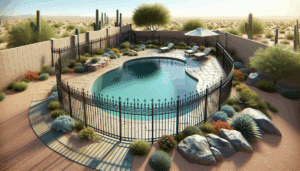Looking to ensure your swimming pool is a safe haven for friends and family? At Pool Safety Fencing, we understand the complexities of pool fence regulations. This essential guide will help homeowners like you navigate the rules and keep your pool compliant. Dive into useful insights and practical advice tailored for the well-being of your loved ones.
Contents
why pool safety Fencing is Crucial
Homeownership comes with responsibilities, especially when there’s a pool involved. Ensuring safety isn’t just about compliance; it’s about protecting lives. Pool safety fencing acts as an effective barrier against accidental drownings, keeping both children and pets safe.
Installing a proper fence not only brings peace of mind but also boosts your property value. It’s a win-win for homeowners, giving you safety and added investment appeal.
Understanding Local Regulations
Each region has its own pool fence regulations, and it’s important to know what’s required in your area. These policies often include guidelines on fence height, gate locks, and materials used.
We want you to feel confident that your pool area meets all local laws and safety standards. Familiarizing yourself with these regulations is the first step toward creating a secure swimming environment.
Types of Pool Fences
Choosing the right type of fence can be overwhelming. There are several options, including mesh, glass, wood, and aluminum. Each material has its own pros and cons.
For instance, mesh fences are durable and provide excellent visibility, while glass offers a sleek, modern look. On the other hand, wood provides a natural aesthetic but may require more maintenance.
Height and Dimension Standards
One key aspect of pool fencing regulations revolves around the height and dimensions of the fence. Typically, pool fences should be at least 4 feet high to prevent children from climbing over them.
Gaps in the fencing should also be minimal, generally not exceeding 4 inches, to ensure small children can’t squeeze through. It’s important to adhere to these dimensions to maintain both safety and compliance.
Gate Specifications
Gates are crucial components of your pool fence. They should be self-closing and self-latching, with the latch positioned at least 54 inches from the ground to keep it out of reach of young children.
Using a lockable latch enhances security and ensures that the gate remains closed when the pool is not in use. This small detail can make a big difference in overall safety.
Material Choices and Durability
Your pool fence must be both sturdy and durable. Popular materials include mesh, aluminum, vinyl, and wrought iron. Each has its own advantages in terms of strength and longevity.
For instance, aluminum and wrought iron are exceptionally strong and weather-resistant, whereas vinyl offers a cost-effective solution with low maintenance requirements. Mesh fences, while not as robust, provide springy resilience and transparency.
Cost Considerations
Investing in pool safety fencing is a significant yet essential expense. Costs can vary based on the material, complexity of design, and installation fees.
Assessing your budget along with your specific safety needs can help you choose the right fencing option. Remember, the initial cost is an investment in the safety and well-being of your loved ones.
Steps to Compliance
Ensuring your pool fence complies with regulations involves several steps, from selecting the right materials to proper installation. Here’s a quick checklist to guide you through:
- Research Local Laws: Familiarize yourself with local pool fencing regulations to ensure compliance.
- Choose the Material: Select a fence material that meets safety requirements and appeals to your aesthetic preferences.
- Hire Professionals: Work with experienced installers to guarantee precise placement and secure construction.
- Install Approved Latches: Make sure gates have self-closing, self-latching mechanisms that are child-resistant.
- Regular Inspections: Periodically check your fence for any damages or wear that could compromise safety.
Maintenance Tips
Maintaining your pool fence is essential for long-term safety and compliance. Regularly inspect your fence for any signs of wear or damage. Rust, loose screws, or broken mesh can all pose potential hazards.
Clean your fence to prevent buildup of debris or algae, which could undermine its structural integrity. A well-maintained fence lasts longer and provides constant protection.
Apply touch-up paint or protective coatings as needed, especially for metal and wood fences. These preventative measures help to extend the fence’s lifespan while retaining its appearance.
Common Mistakes to Avoid
Too often, homeowners make avoidable mistakes when installing pool fences. One common error is not properly measuring the height, resulting in a fence that doesn’t meet regulatory standards.
Another frequent oversight is choosing a non-durable material that wears down quickly, reducing its effectiveness. Additionally, poorly installed gate latches can fail to provide the required level of security.
Getting Professional Help
When in doubt, seeking professional assistance can streamline the entire process. Experts like us at Pool Safety Fencing offer valuable insights and skilled craftsmanship to ensure your fence is both attractive and secure.
From initial consultation to final installation, having professional support can save you time, money, and stress. Feel free to reach out for personalized recommendations and a no-obligation quote.
For any additional questions or to get started on enhancing your pool’s safety, give us a call at 480-771-8026 or request a free quote.




